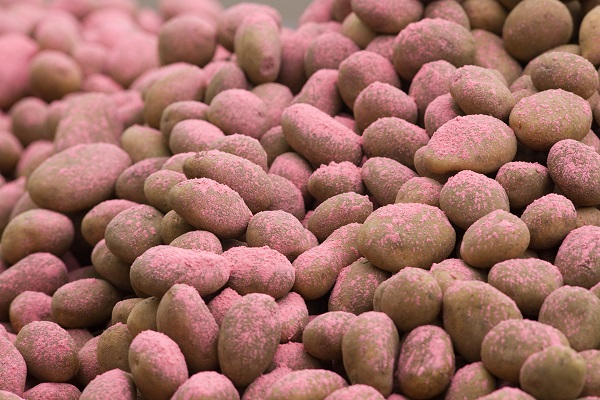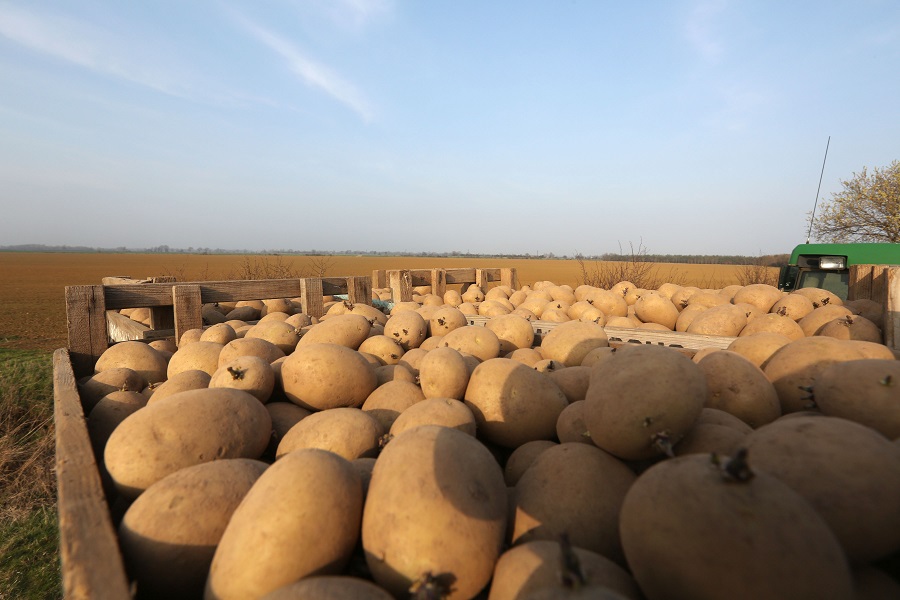A few weeks ago Bayer voluntarily withdrew their stalwart potato seed treatment, Monceren. For growers who’ve relied on the treatment for many years it means a change of strategy. CPM looks at the considerations.
All of the alternatives to Monceren have their merits.
By Rob Jones
For more than a decade, growers have relied on Monceren DS (pencycuron) to control black scurf and reduce the incidence of stem canker, two diseases caused by Rhizoctonia solani that have the potential to reduce yields and quality. Recent proposals to alter the maximum residue limit published by the European Commission have led product manufacturer Bayer to withdraw Monceren from the market, meaning many growers will have to find another means of protecting crops.
So why has Bayer taken this unprecedented step? Bayer’s Edward Hagues explains that the EU proposal was to reduce the MRL for pencycuron to just one-tenth of the existing level.

Monceren seed treatment has been voluntarily withdrawn due to the implications of a possible change to its MRL.
“The outlook is far from clear, but if the proposal is adopted it would mean all seed would have to be treated before April 2020 and all harvested potatoes sold by Oct 2020 to avoid contravening the new MRL,” he says.
“Clearly this is impractical, so Bayer was left with little alternative but to suspend Monceren sales with immediate effect. Should the proposals be dropped or a new MRL that is more favourable to Monceren be proposed, Bayer will resume sales,” he adds.
Bayer data shows that Monceren DS, which is the powder form, was the preferred means of treating seed potatoes against the effects of R. solani, probably because it was easy to apply, relatively inexpensive and highly effective, comments Edward.
Aside from its reliable control, Monceren appealed to growers because it could be applied to seed without specialist equipment, he believes. “In recent years many growers have chosen to install on-planter applicators to improve the accuracy of application and ensure all seed was treated. Separate manual application directly over the seed in the hopper simply couldn’t match the accuracy of application nor operator safety delivered by on-planter machinery.”
The non-availability of Monceren means those growers who have in the past opted for separate application now have to choose from the alternative methods. “For the majority, the decision will likely be determined by which system (liquid application over a rolling conveyer or table or on-planter applicator) best suits their situation. For others, it’ll be more important to ensure the best possible level of protection.
“All of the alternatives to Monceren, Emesto Prime DS (penflufen), Rhino (flutolanil) and Maxim 100 FS (fludioxonil) have their merits, but I would urge growers to make their choice based on which product delivers the greatest marketable yield,” says Eric Anderson, senior agronomist with Scottish Agronomy.
“Most growers don’t bother with testing seed for R. solani because they know it’s likely to be seated in the eye tissue, even if black scurf is not visible on the tuber. Also because tuber treatments are a reasonably inexpensive means of protection, it makes sense to use them as a matter of routine. But there may be some growers who’ve forgotten how effective tuber treatments are,” he adds.
Some growers might choose to plant untreated seed, but this would be to underestimate the incidence of the rhizoctonia carried on seed, comments Eric.
It’s a valid concern and one that was highlighted by AHDB seed testing, performed as part of its review of rhizoctonia management practices. The levy body found that in GB, 70% of seed had detectable levels of inoculum (using PCR) and 47% had visual (black scurf) symptoms in 124 seed stocks assessed both visually and with real-time PCR between 2005 and 2007.
Identifying which treatment gives the best protection is far from easy, points out Eric. “There’s a difference in performance between products that isn’t reflected in the AHDB literature. From our experience, Emesto Prime sets the new benchmark for protection against seed-borne rhizoctonia and adheres to the seed just as well as Monceren did,” he says.
The loss of diquat is something else growers should factor in when it comes to making seed treatment decisions, highlights Eric. The alternative desiccation methods will all mean an increased threat of black scurf infection.
“Black scurf invasion is most rapid after senescence starts or haulm destruction, but because diquat was a fast-acting desiccant it meant the time elapsed between spraying and lifting was reasonably short. This afforded some protection of its own, but without diquat the time between destruction and lifting is likely to be much longer, increasing the threat of rhizoctonia infection. This highlights the need to use the best means of protection,” he says.
Once a seed tuber treatment has been decided upon, the next consideration is how best to apply it. This is where growers who previously applied Monceren by ‘the sandwich technique’ need to think ahead, explains Danny Hubbard of equipment manufacturer Team Sprayers.
“We have an effective solution in the Team Powder Applicator and are the only manufacturer with an on-planter applicator already calibrated for Emesto Prime. The applicator, which can be retrofitted to most brands and sizes of planter, uses an auger to apply a measured quantity of product to the seed potatoes as they pass along the belt or into the cups, depending on the machine used. Because the process is short in time and distance involved, there is minimal wastage,” he explains.
“The discharge rate will vary according to ground speed so as to maintain a constant application rate, while the applicator itself contains an agitator to prevent the product from bridging inside the hopper. Growers using a Digimon controller programmed with version 4.1b, or later, will already have the settings needed for Emesto Prime pre-installed. Those running earlier versions can have them updated by returning them to us,” he adds.
Another on-planter solution is the Techneat Powder Pro which also uses an auger to measure out powder, says Tom Neat of Techneat Engineering.
“We have an effective solution in the Powder Pro powder applicator which can be retrofitted to most brands of cup and belt planter, including Standen and Grimme. It uses a 25-litre hopper, which limitd the number of fill-ups required, and the rate control box can be connected to a GPS sensor or the tractor’s ISOBUS terminus to ensure the application rate is maintained, even during changes in forward speed,” he says.
“It’s important to ensure that the machine is properly calibrated to the product being applied,” adds Tom. “All the available powders have different densities, so operators should not assume that the calibration settings for one treatment will be suitable for another.
“Calibration is a simple process, with a dump test carried out to determine the product output in grams over a known number of auger revolutions. The rate-controller setting is then updated to ensure an accurate application is achieved,” he says.
Open eyes to Maxim seed treatment
Crops protected with an effective seed treatment can quickly build bigger and stronger root systems, which are able to support higher number of tubers with more even size and maturity at harvest, according to extensive trials undertaken by Frontier Agriculture.
Paul Overton, the company’s potato seed treatment specialist, reports the trials with Maxim (fludioxonil) have shown it will consistently enable more eyes to open and stimulate extra rooting.
“More viable eyes which increase stem numbers per ha is key to increasing overall yields,” advocates Paul. “On farm, that has translated to more even initial movement in the seed storage box, and typically means crops are faster to reach 100% emergence.”
He believes achieving a more consistent crop with the seed treatment has benefits for agronomy right through the season.
Frontier’s dedicated store at Sutton Bridge has been designed specifically to accelerate seed-borne diseases on seed lots. “If we can identify seed issues before planting, it gives the chance to make the best decisions on what treatments to recommend. We can also get a better understanding of Maxim treatments on different varieties.”
For salad varieties, he reports combinations of ethylene and Maxim have been shown to stimulate far greater shoot numbers. For varieties that typically exhibit strong dormancy, such as processing varieties Brooke and Taurus, they’ve appeared more likely to break dormancy with the seed treatment, he points out.
“Stolon numbers are the absolute framework for carrying tubers and increasing the yield potential. With the Maxim treatment the cleanliness and vigour of the stems is incredible, so growers and agronomists can really begin to influence potato plant population dynamics for higher yields and marketable quality.”
Fludioxonil is particularly well suited as a seed treatment since it’s relatively immobile in the soil, meaning it surrounds the tuber and protects roots for longer. “Treatment in store pre-planting is controlled, convenient and saves another task for planter operators,” says Paul.
Field trials and lab studies by Frontier and Syngenta, have shown in-store application has beneficial all-round effects on a range of skin diseases, including skin spot and fusarium, as well as R. solani, black dot and silver scurf, which are all on the Maxim label.
For growers buying in bagged seed, unloading into boxes within 48 hours of arriving on farm provides an ideal opportunity for Maxim treatment, he highlights.
“Over past seasons most of the seed treatment has been applied at source or by a specialist contractor on-farm, but many growers are now kitting up with their own applicators for convenience and greater selectivity, targeting seed to for specific fields or risk situations.”




